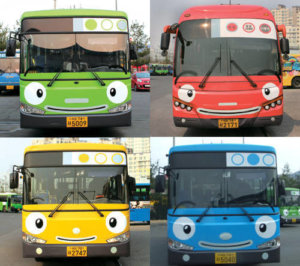Subways, Trains and Automobiles: Your Guide to Public Transportation in Seoul
One of the hardest aspects of moving to a different country is learning how to maneuver public transportation.
But it doesn’t take long to figure out why Korea is known for having some of the best transportation in the world. From the intricate subway layout, to hailing a taxi, there are more than enough ways to make sure you get to work on time without worrying about running out of gas! Here are the most common forms of transportation in Seoul and how to use them efficiently:
Taxis in Seoul
So you’ve just arrived in Korea and you’re waiting at the airport to go to your new home. With all that luggage, carrying it onto the subway does not seem like a challenge you want to tackle at the moment. Well, you’re in luck– taxis are a quick and easy way to navigate around the city. The base rate for a Taxi begins at 3,000 won (about $2.75) and goes up from there. Not many of the drivers will speak English, but if you bring a map or just the address of your location and show it to them, you’ll be well on your way. If you haven’t brushed up on some key phrases, and you’re feeling especially ambitious and want to smash that language barrier head-on, you can dial 1330 on your phone and be connected with the Travel Hotline who will help translate (it’s a life-saver, trust me).
Taxis are easily available around the city and near airports. If you are not near a taxi stop (they’re everywhere), you can wave one down from the side of the road. However, it is usually courteous to hail a Taxi going towards the direction you want to go in (if either of you know which way that is! Korean traffic can be a little crazy!). At the end of your ride you will be able to pay with cash, card, or T-Money. Pro tip: make sure the meter is running to avoid getting over-charged!
Seoul Subway System

Commuters pack a platform at Seoul Station in central Seoul after a subway train broke down and halted operations on line No. 1 for nearly five hours during morning rush hour. Korea Times photo by Kim Joo-sung.
The Seoul subway system is no joke. The subway runs from about 5:30 AM to 24:00 (Midnight). To ride about 6 miles in the subway will cost you around 1,250 won ($1.15), which is around 11 stations on the subway. The subway runs on a fairly strict schedule and there are lots of apps in English that can show you which direction and how much your ride will take. For the subway, you will need one of those handy T-Money cards I mentioned earlier. They can be bought at The Arrival Store, or bought and refilled from a machine inside metro stations.
Pro-tip: starting from around 4:30 pm to about 8:00 pm, the subways will usually be very crowded. So, get used to getting, ahem, intimate with strangers in Korea! A personal tip of mine is to go all the way in the front, or all the way in the back to claim some breathing space. These cars are usually the least busy and sometimes have even more standing space for you. Either that, or get in the thick of it and embrace the Korean public transport experience!
Buses in Seoul

Just like the subway system in Seoul, the bus system is equally pretty hardcore (I mean, just look at those adorable– er– formidable buses!). While the ride might be a little bumpy, it is comparatively cheap and can be quicker than the subway for short distances. A bus ride might cost you around 1,200 won and around 1,300 won if you pay with cash. So, when you see one of those colourful badboys passing by, don’t be afraid to hop on!
Blue buses transit from suburban parts of Seoul to downtown areas, while green buses are private company buses that transit people to major subway stations in the city. Red buses are express buses that move passengers from downtown Seoul to the outer edges of Seoul and at times to adjacent suburbs. Yellow buses go around in circles in the downtown area, connecting major locations in the area.
Pro tip: When you get on the bus, make sure to tap your T-Money on the machine by the door. You will need to tap your card again as you get off or else it will continue charging you and –trust me– you will only make that mistake once! Once again, there are numerous smartphone apps to make sure you get the right bus, so don’t worry too much about getting lost. Just look for the number of the bus you need and listen carefully for the upcoming destinations.
You’ll be on your way in no time.
Public ransportation in Seoul absolutely amazing. It may seem intimidating at first, but with careful planning and lots of practice, you will be on your way in no time! Want to get ahead of the game and have a T-money card waiting for you when you get off the plane? Order one below!
About the Author:
Gwen McLin is an American living in Seoul. She’s a strong believer in the three C’s; cats, coffee, and cameras. If you can’t find her sipping an Americano in a cafe, you can probably find her taking pictures of the scenery around Korea or watching internet cats. She loves taking long walks around the city and trying to learn something new each day.